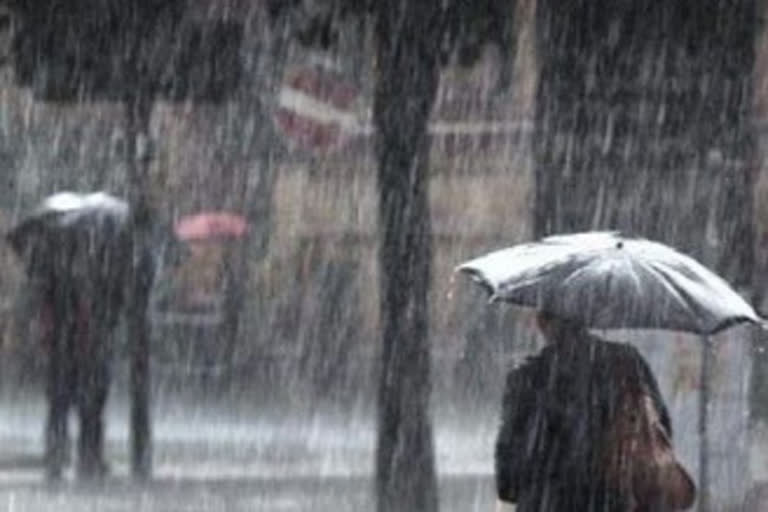Guwahati: The four-month-long monsoon was the most uneven in the mountainous northeastern region. Four of the eight northeastern states, including Assam, have received excess rain while the remaining four reported rainfall deficit.
Even as the India Meteorological Department (IMD) termed 19 per cent excess or shortage in rainfall as 'normal' monsoon, Himalayan state Sikkim and mountainous Meghalaya recorded 60 and 39 per cent excess rainfall respectively while Manipur and Mizoram witnessed 47 and 34 per cent deficient rainfall.
The 4-month long monsoon season in India officially starts on June 1 and continues till September 30. According to the IMD officials, the withdrawal of monsoon from west Rajasthan and parts of Punjab started on September 28 while its withdrawal in the northeastern region normally takes place the second week of October. According to the Indian Council of Agricultural Research (ICAR) scientists, the erratic monsoon is likely to affect both the Kharif and Rabi crops in the region.
As per the IMD records, between June 1 and September 30, Sikkim recorded plus (excess) 60 per cent rain, Meghalaya plus 39 per cent, Arunachal Pradesh plus 13 per cent and Assam plus 11 per cent. Manipur recorded minus (deficit) 47 per cent rainfall, Mizoram minus 34 per cent, Nagaland minus 26 per cent and Tripura minus 11 per cent.
Read:| Heavy to very heavy rainfall likely over Northeast India in next 5 days
According to IMD officials and experts, the four-month-long southwest monsoon (June-September) is in full swing in most parts of the hilly northeastern region which in most years recorded a good monsoon. IMD scientist Ranjan Phukan said as the monsoon trough was mostly active along the foothills of the Himalayas, Sikkim, Assam, Arunachal Pradesh and Meghalaya recorded good and heavy monsoon rains.
"Until the first half of the monsoon, it was good rainfall in four northeastern states. One after another low pressure in Bay of Bengal, the monsoon trough and related wind condition moved to eastern and central India region skipping the northeastern states causing less rainfall in various states," Phukan told reporters over the phone.
According to the disaster management officials, monsoon floods and landslides have claimed 146 lives in Assam, 15 in Arunachal Pradesh, 10 in Meghalaya and one in Tripura. ICAR's Principal Scientist Shankar Prashad Das said that the erratic monsoon would affect the Kharif crops in the northeastern region.
"During the tillering stage of the crop, the short rainfall would affect the production, productivity and otherwise. Distribution of rain is very erratic in the region. The deficient rainfall would affect the crops in Mizoram followed by Nagaland, Manipur and Tripura," Das told IANS. According to Das, the reproduction phase of the crops would also be affected in the northeastern region due to the unreliable rainfall.
"Good rainfall in August is very crucial for various crops in the northeast and this year, during August, rainfall was either less or uneven in the region," the ICAR's Principal Scientist pointed out.
Like the previous years, Assam this year too witnessed devastating floods that killed 120 people in 22 districts, while 26 others were killed in landslides since May 22. With a respite from the monsoon rains, the situation improved significantly in the first week of August even as 57 lakh people have been affected in 5,378 villages in 30 of the state's 33 districts.
"With heavy rainfall in last part of September, the flood created havoc in 13 of the 33 districts in Assam," Assam State Disaster Management Authority (ASDMA) officials said. According to them, a total of 2,65,402 hectares of crops in 30 districts were badly affected while the worst-hit 11 districts are Goalpara, Morigaon, Bongaigaon, Dhemaji, Baksa, Nagaon, Kokrajhar, Dhubri, Sonitpur, Jorhat and Kamrup.
Read:| Assam floods: NDRF carry out rescue operations in affected areas
The floods also badly hit domestic and wild animals in various sanctuaries and national parks including the world-famous Kaziranga National Park, where 18 rhinos and 135 wild animals died due to the deluge. Kaziranga National Park Director Karmashree P. Sivakumar said that 172 wild animals have been rescued from the floodwaters, even though over 95 per cent of the park remained inundated until July 23.
"Last year, 263 animals, including many endangered rhinos, were killed in floods while 169 animals were rescued...all-out efforts are being made to take care of the animals in the entire Kaziranga National Park," Sivakumar told reporters over the phone.
The animals that perished this year in the park include 18 rhinos, 107 hog deer, 12 wild boars, six wild buffaloes, four porcupines and three swamp deer. The 172 rescued animals include three rhinos, 120 hog deer, 31 pythons and four cobras.
Various NGOs and individuals including Bollywood actor Akshay Kumar have donated money and provided relief material to the flood-affected people.
IANS report



